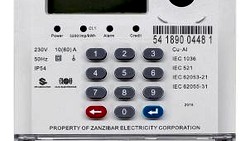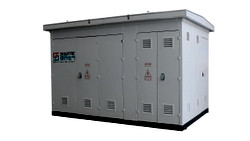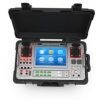When we talk about power we always need to indicate the direction and which sort of power.
We can have:
- Active power, P
Active power is expressed in watt (W). Sometimes this power is also called "real power"
This is the power you are actually consuming. - Reactive power, Q
Reactive power is expressed in volt-ampere reactive (var)
This power is stored in components, then released again back to the source through the AC cycle. Capacitors and inductors do this. - Apparent power, S
Apparent power is expressed in volt-ampere (VA)
(RMS voltage times the RMS current). A power supply must be capable to output the full apparent power delivered to a circuit, not just the active power.
Quadrant I
Quadrant I is defined as an area where both powers flow positively. Both are delivered to the consumer load. In many cases the CLOU terminology is forward. The power factor is lagging, we have inductive influence.
The IEC literature is using the term import.
In this quadrant we have Import of active power and Import of reactive power.
Quadrant II
In quadrant II, reactive power is positive and active power flows negatively. In many cases the CLOU terminology is reversed. The IEC literature is using the term export.
Quadrant III
In quadrant III, reactive and active power flow negatively (both powers are received from the customer). This is also a export condition.
Quadrant IV
In quadrant IV, reactive power flows negatively, and active power flows positively. This is a import condition.
The interactive diagram below shows the relationship between the phase angle φ, apparent-, active- and reactive power respective energy. The diagram is in accordance with clauses 12 and 14 of IEC 60375. Reference is the current vector (fixed on right-hand line, 0°). The phase angle φ between voltage V and current I is taken to be positive in the mathematical sense (counter clockwise).
Four Quadrant Simulation (IEC62053-23)
Geometric representation of active and reactive power
Note: The sine-wave diagram was changed to mathematical expression with reference on current (green). The oscilloscope view with reference on voltage was leading to misunderstanding. (24.11.2020)
Thank you for taking a look and for valuable comments.
Editor's note: This article was originally published in July 2019 and has been updated for comprehensiveness.








Hi Dear!!! TheCutomer Load Found In The Fourth Quaderant .Which Means Active Power Flows Positively And Reactive Power Flow Negatively Since Import Condition (Capacitive Load)
, Because The Current Leads The Voltage But The Customer Still Penalazed By Power Factor Why????
Thank you for the question. The power factor is defined as the ratio of the active power (measured in watts) to the apparent power (measured in volt-amperes). So your consumer is causing a loss for the utility. If the power factor is too low, the utility is charging a penalty. Your only option is to compensate the power factor. A negative flow of reactive power is useless for the utility.
Hello Mr. Laoren,
Should the total reactive register in the meter include the inductive load (Q1+Q3 ) and capacitive load (Q2 +Q4) or only the inductive load (Q1 + Q3)?
Also the same question about the power factor , Should the power factor calculate based on reactive energy for the four quadrants or only (Q1+Q3) ?
Usually you would record Q+ (sum of Q1 + Q2) and Q- (sum of Q3 + Q4). All other combinations are not helpful for further evaluations. Same for the power-factor.
To calculate the total PF for import P+, you take the sum of Q1 + Q4. For export P- you take the sum of Q2 + Q3. Modern four-quadrant meters are holding extra registers to read out the sum (e.g. Q+, OBIS code 3.7.0).
Dear Mr. Laoren, thank you very much for the response! It is very much helpful!
Thank you, Samuel. Glad to help.
Dear Mr. LAOREN, Here I have some questions which is related to the implementation of changing previous Active Reactive meters to four quadrant metering meters in our governmental electric utility company. And in our central reading collecting system we've got these conditions
1) Most of the customers show consumption readings in Q1 and Q4 which is normal and expected since all our customers are importing not exporting.
2) Some show consumption readings in all quadrants Q1,Q2,Q3 and Q4 all increasing in each consecutive months
3) Some show consumption readings in Q2 and Q3 only
What could be the reason for the abnormal conditions of 2 and 3?
What is the effect on Maximum demand on the abnormal conditions of 2 and 3?
Our system is adjusted to calculate billing using Q1 and Q4 consumptions since all our customers are importing, what could be a solution in billing for 2nd and 3rd conditions?
Hi Samuel, thank you for your good description and questions.
#1, you are right. This is the normal condition for import.
#2 This is a tricky case. If the user has heavy electrical machinery which is switched off, you have a short-time reverse current. More likely possible is a high resistance in the three-phase neutral circuit or the user has don't a solar panel installation without noticing you. This you need to debug on-site with a portable tester, e.g. RS350.
#3 This is easy. The meter is connected reverse. In case of CT- or CT/PT meters, the reversal can also come from wrong installed instrument transformers.
The maximum demand is typically only considered for P+. So in your case #2 you won't get the full value while you get no records in case #3.
The quick and easy solution for billing is, you take the absolute values in your system software, e.g. (P∑ = |P-| + |P+|), but you need to make sure that all customers are only importing. Still, I suggest fixing the problem at customer site.
Informative answers 👍
Thank you
Hello LaoRen,
Do advanced meters record Q1,Q2,Q3 and Q4 Consumption for Active energy and reactive energy ? or just for reactive energy?
and i have another question , is there difference between the active & reactive energy and the active & reactive power in the energy meters?
Thanks in advance.
The four quadrant measurement is for reactive energy only. For active, you have P+ and P-.
For the second question, energy is power multiplied by time.
hi sir, my meter only reads KW component but not KVAR. What possibly would be the cause of that?
It depends on your meter. Simple energy meters are only recording kWh. If you have an advanced meter, click on the scroll button to see the reactive component. You might scroll several times to see kvar or kvarh.
hi dear my power factor reads 0.94. but active power reads 48 kWh and reactive power reads 63.5 kvar . how this happen
Thank you for your question. Only from your given figures, I would say, you read the wrong register for active power. You are indicating 48 kWh, which is representing an energy, while your 63.5 kvar is a power value.
Our billing system is to compute by taking three para meters these are Active energy (kwh), reactive energy (Kvarh) and max. demand ( Kw) .In order to calculate the average power factor of the month, we have to take the reading of Kvarh so where shall we take the reactive component from the first or the fourth quadrant as per the obis cod.
Thank you, now it's clear. For average power-factor calculation, you take the SUM of Q1 + Q4. You don't know whether the reactive energy is inductive (Q1) or capacitive (Q4). The load can also sometimes change from Q1 to Q4.
Thank you indeed Mr. LAOARN , We are Electricity seller company so I am expecting to take the reading from positive parameter import quadrant i.e first only . Am I right? Last time when the there was a discrepancy of one phase current connection , we couldn't take a maximum demand reading . While we changed the connection of the current terminal in the correct way all the reading was displayed including max.demand in Kw . What was reason behind Sir.?
b.regards,
Masresha
The quadrants are to capture the reactive power (Q). For consumption billing, you take the active power (P). The import (P+) is always moving horizontal, so the active import doesn't have a quadrant indication. It's between Q1 and Q4. You won't find an active energy register with quadrant indication. Look at the units. Active energy has kWh while reactive energy has kvarh.
For the display, the best guess is that the meter has rebooted during the connection change and then performed a self-test. This can lead to several display indications. But should be fine after 10 seconds.